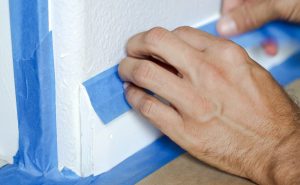
How to Paint a Newly Textured Wall
Posted on October 25, 2020
 Textured walls are a good option when coving up imperfections in the paint like nail holes, dings, or spackling errors. If there are issues with the drywall placement, sometimes even the best paint jobs will show the issues. Textured walls offer an attractive option to mitigate some of these kinds of problems.
Textured walls are a good option when coving up imperfections in the paint like nail holes, dings, or spackling errors. If there are issues with the drywall placement, sometimes even the best paint jobs will show the issues. Textured walls offer an attractive option to mitigate some of these kinds of problems.
When painting textured walls, the project can become more difficult than painting a flat surface. Using the correct types of brushes and equipment is important when painting a textured wall. You will also need more paint, and there may be a higher potential for paint splatter.
Before you paint
Tape off anything you do not want to be splattered. It’s a good idea to get a wider width painter’s tape and put down more than you expect to need. Press the edge down hard with a putty knife. Use a drop cloth taped down, or flattened cardboard boxes to cover the floor. Cover the entirety of your windows and wear old clothes you don’t mind getting paint on.
Supplies
The raised texture of your walls creates a uniquely uneven surface. The nap on your roller has to be deep enough to reach the valleys in the texture. A roller with a ½ inch to ¾ inch nap is best. It will absorb more paint and be very heavy when it’s loaded. If you’re using a brush, try a 2-inch angled brush for corners.
Paint
Buy extra. More paint is going to be used in painting a textured room, than a flat wall. It’s a good idea to get the trim color as well. The potential for having to repaint the area under the tape is very high. Remember, splatters and nap use paint up quickly too.
Technique
Paint the edge of the tape on the trim with the trim paint color. It will seal any imperfections in laying the tape down with the color that’s under it. This prevents your new color from seeping into tape bubbles and filling up. Paint the textured wall the same as any other. Use a W-shaped motion. Don’t press too hard, or the paint will run. Cover all of the walls, let it dry and repeat.
Removing tape
Once dry, use a box knife to cut the line between the tape and the newly painted wall. Don’t cut deep or you’ll end up with a cut in your new paint. Slowly but firmly pull the tape off the wall. You may have to touch up areas where the paint seeped through the tape.
If you need help with an interior painting project and live in the Northridge, Granada Hills, or Santa Clarita areas of Los Angeles, we can help. Set up a free estimate appointment with our team to get started.





